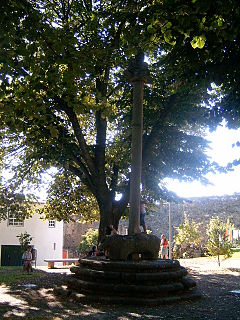
The pillory is a device made of a wooden or metal framework erected on a post, with holes for securing the head and hands, formerly used for punishment by public humiliation and often further physical abuse. The pillory is related to the stocks.

Stocks are restraining devices that were used as a form of corporal punishment and public humiliation.

A chain gang is a group of prisoners chained together to perform menial or physically challenging work as a form of punishment. Such punishment might include repairing buildings, building roads, or clearing land. This system existed primarily in the Southern United States, and by 1955 had largely been phased out nationwide, with Georgia among the last states to abandon the practice. North Carolina continued to use chain gangs into the 1970s. Chain gangs were reintroduced by a few states during the "get tough on crime" 1990s, with Alabama being the first state to revive them in 1995. The experiment ended after about one year in all states except Arizona, where in Maricopa County inmates can still volunteer for a chain gang to earn credit toward a high school diploma or avoid disciplinary lockdowns for rule infractions. The introduction of chain gangs into the United States began before the American Civil War. The southern states needed finances and public works to be performed. Prisoners were a free way for these works to be achieved.

Public humiliation or public shaming is a form of punishment whose main feature is dishonoring or disgracing a person, usually an offender or a prisoner, especially in a public place. It was regularly used as a form of judicially sanctioned punishment in previous centuries, and is still practiced by different means in the modern era.

Cucking stools or ducking stools were chairs formerly used for punishment of disorderly women, scolds and dishonest tradesmen in England, Scotland, and elsewhere. The cucking-stool was a form of wymen pine, or "women's punishment," as referred to in Langland's Piers Plowman (1378). They were both instruments of public humiliation and censure primarily for the offense of scolding or back biting and less often for sexual offences like bearing an illegitimate child or prostitution.

A cangue or tcha is a device that was used for public humiliation and corporal punishment in East Asia and some other parts of Southeast Asia until the early years of the twentieth century. It was also occasionally used for or during torture. Because it restricted a person's movements, it was common for people wearing cangues to starve to death as they were unable to feed themselves.

To run the gauntlet is to take part in a form of corporal punishment in which the party judged guilty is forced to run between two rows of soldiers, who strike out and attack him.
The Great Stock Exchange Fraud of 1814 was a hoax or fraud centered on false information about the Napoleonic Wars, affecting the London Stock Exchange in 1814.

Nelas is a municipality located in the Centro Region of continental Portugal. The population in 2011 was 14,037, in an area of 125.71 km².

Curious Punishments of Bygone Days is a history book published in 1896. It was written by Alice Morse Earle and printed by Herbert S. Stone & Company. Earle was a historian of Colonial America, and she writes in her introduction:
In ransacking old court records, newspapers, diaries and letters for the historic foundation of the books which I have written on colonial history, I have found and noted much of interest that has not been used or referred to in any of those books. An accumulation of notes on old-time laws, punishments and penalties has evoked this volume.

The Pranger of Poznań is found near the north-east corner of the Town Hall, not far from the Prozerpina Fountain. It is an eight-sided, late-Gothic column, on the summit of which stands a statue of an executioner in a Crusader's outfit holding a raised sword. The current pranger is a copy made by Marcin Rożek in 1925. The original is in the Museum of History of Poznań in the town hall. The pranger was constructed in 1535, financed by fines extracted from workers who wore too-elaborate outfits. The pranger was used to exact punishment through flagellation or the removal of ears or fingers.

Perg is a city in the Austrian state of Upper Austria, capital of the district of the same name.
Cyphonism was a form of punishment using a κύφων, a kind of wooden pillory in which the neck of a malefactor would be fastened. Formerly, this term was widely believed to refer to scaphism, a form of punishment or torture in which a person's naked body was smeared with honey, and exposed to flies, wasps, and other pests.

Elizabeth Needham, also known as Mother Needham, was an English procuress and brothel-keeper of 18th-century London, who has been identified as the bawd greeting Moll Hackabout in the first plate of William Hogarth's series of satirical etchings, A Harlot's Progress. Although Needham was notorious in London at the time, little is recorded of her life, and no genuine portraits of her survive. Her house was the most exclusive in London and her customers came from the highest strata of fashionable society, but she eventually ran afoul of the moral reformers of the day and died as a result of the severe treatment she received after being sentenced to stand in the pillory.

Cropping is the removal of a person's ears as an act of physical punishment. It was performed along with the pillorying or immobilisation in the stocks, and sometimes alongside punishments such as branding or fines. The punishment is described in Victor Hugo's The Hunchback of Notre-Dame.

The Pillory of Bragança is a 15th-century sculpted stone column with symbolic political, administrative and judicial significance, erected over a four-step octagonal platform, located in the civil parish of Sé, Santa Maria e Meixedo, municipality of Bragança. It consists of a cylindrical column erected over a square platform, sculpted with zoomorphic symbols, anthropomorphic scenes and the shield of the city of Bragança. Its structural design and sculptural ornamentation is characteristics of the era; the column is classified as a National Monument since 1910.
Margaret Pearson, also known as the Padiham witch because she lived in the town of Padiham in Lancashire, England, was among those tried with the Pendle witches in the Lancashire witch trials of 1612. This, her third trial for witchcraft, took place on 19 August at Lancaster Assizes in front of Sir James Altham and Sir Edward Bromley.

Events from the year 1855 in Sweden

Inform Napalm is a volunteer initiative to inform Ukrainian citizens and the foreign public about the undeclared war against Ukraine, the annexation of Crimea, and the activities of the Russian special services as well as the militants of the so-called "DPR", "LPR", and "Novorossiya". The team members are engaged in a wide range of other volunteer activities. In order to inform the foreign audience, authors translate materials to dozens of languages, including Japanese and Chinese.
Katharine "Ketty" Guttmann was a German Communist politician and campaigner for prostitutes' rights.
















